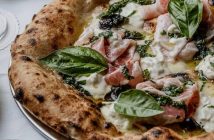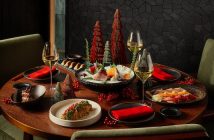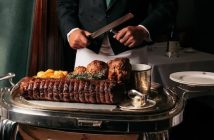Fresher’s Week is a time for mistakes, and one of mine was to sign up for the university Wine Society. I’d hoped for decadent evenings spent quaffing fine wines from cobwebbed vaults; instead, we gathered in a strip-lit seminar room listening to a postgraduate pontificate on his favourite grape, receiving barely a thimbleful for our troubles. As a sop, it was stale baguette, and if we were lucky, a tub of supermarket hummus, its plastic lid used as an ad hoc doily.
Thankfully, times have moved on, and this week I had the opportunity to partake in a wine tasting of an entirely different calibre.
Opened in 2016, Margot is an opulent Italian restaurant at the Holborn edge of Covent Garden. Its co-proprietors have serious front-of-house pedigree – Paulo de Tarso worked at the Wolseley and Scott’s, and helped set up Bar Boulud at the Mandarin Oriental; Nicolas Jaouën is another Scott’s alumnus, who went on to open Balthazar London for Keith McNally. As might be expected, the restaurant is quite something to behold, decorated in luxurious leather and gilt, with abstract art on every wall. Even the name shows a generosity of spirit – it’s christened in honour of Paulo’s mother-in-law.

Margot’s monthly wine tasting dinners are held downstairs in the Club Room, where two rows of lucky guests are seated on blue leather banquettes, facing out on perfectly appointed tables. A passionate winemaker shares the benefit of their experience at each dinner, whilst the wines are accompanied by five delicious courses, individually crafted by Executive Chef, Massimiliano Vezzi, and Head Sommelier, Sabrina Manolio.
On the evening I attended, the wine in question was champagne, and the producer one of the most venerable in France (though not yet as well-known in the UK), Champagne Deutz. Monsieur Deutz himself being long dead (1809-1884), it was the International Director of the company, Liza Le Floch, who guided us through the tasting.
Liza began by reassuring us that champagne is a wholly sensible accompaniment to a meal. The Brits may constitute the largest export market for champagne in the world, but they still cling to the notion that bubbly must be saved for a celebration, or served as an apéritif. This, Liza suggested, is an anachronism from the days when champagne was a sweet drink full of sugar. Modern champagnes (and Deutz in particular) have been steadily decreasing the amount of sugar they use for fermentation, resulting in a subtle, dry wine that can be enjoyed with food in the same way as any other white.

I was tempted to point out that many people don’t drink champagne with food due to its expense, but this was a time for indulgence, not quibbles, so we plunged into our first flute – the Deutz Brut Classic. The champagne’s delicate mousse seemed to tickle every ounce of flavour from the two paprika-dusted scallops that accompanied it. I could get used to this, I thought.
Next up was a rosé, and Liza was on hand with another soupçon of champagne history. Pink champagne, she revealed, was once a sign of poor winemaking. Two of the three grapes used to make champagne (pinot noir and pinot meunier) are black, so any colour in the end product was a sign that their skins had been accidentally allowed to adulterate the wine. At some point, however, someone decided to taste a bottle of this defective champagne – and finding it was good, Deutz Rosé Brut was born.
Margot’s food pairing with the rosé was a stroke of genius – a carpaccio of sweet, soft Sicilian prawns. For a moment, everyone fell silent, the quintessence of pink overwhelming their palates.

Then the flutes were cleared, and the next two champagnes poured into wineglasses. Liza declared them both so similar in body and minerality to white wine that they should be drunk in the same way. So with our rigatoni and spider crab, we enjoyed a Deutz Blanc de Blanc Brut. Somehow, the wide-brimmed glass acted as a foil to the fizz, so that one might have been sipping a glass of crisp chardonnay with our plate of fresh pasta. Next came the burlier cousin of the blanc de blanc, the Deutz Brut 2012. As promised, it was more than robust enough to complement the meatier course of monkfish tail encased in salty pancetta.
For pudding, it was back to a flute, and back in time as well – 18 years in fact, to the vintage Cuvée William Deutz Brut 2000. Its long sojourn in the bottle had aged it to a gorgeous caramel colour, and the sweet notes of apricot were reflected in the dish of wild strawberries, caramelised black olives and basil ice cream that accompanied it.
Finishing my last glass of champagne, I realised it had been bottled while I was still attending university wine tastings. Margot had confirmed the truth of an old saying: some things do improve with age.
Margot’s Wine Dinner Series continues on Monday 23 April, with the focus on the Loire Valley and two brilliant winemakers from the region – Patricia Teiller and Fredrick Filliatreau. Patricia Teiller produces wines in the area of Menetou Salon and Fredrick Filliatreau produces wines in the area of Samur-Champigny – just a few kilometres between the two, but extremely different style of wines. With this dinner they will show, glass by glass, the beauty of the wines from the Loire Valley, and the diversity that the region offers, telling the story of two winemakers and showing the difference between the two areas. Held in the Club Room, tickets are priced at £95pp, arrival 6.30pm for dinner at 7pm. For more information, and to book tickets, call 0203 409 4777 or email reservations@margotrestaurant.com.
Margot, 45 Great Queen Street, Covent Garden, London WC2B 5AA. www.margotrestaurant.com




